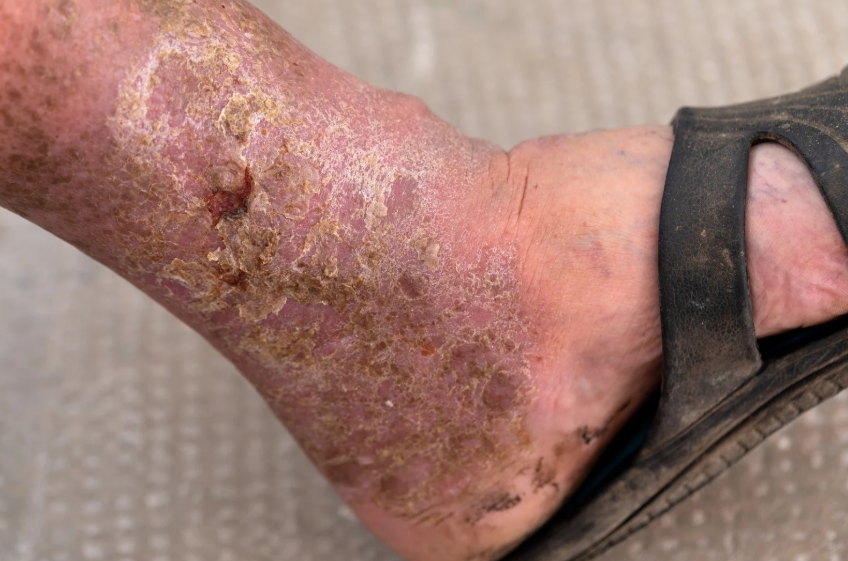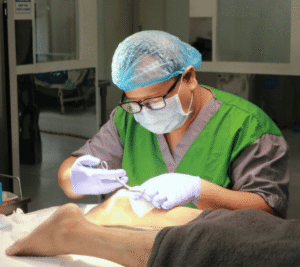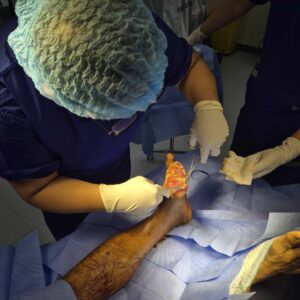Forefoot ulcers are a serious medical condition that can significantly impact mobility and quality of life. These ulcers develop due to excessive pressure, poor circulation, and underlying conditions like diabetes or neuropathy. Without proper care, forefoot ulcers can lead to severe infections, tissue damage, and even amputation.
Orthopedic treatment for forefoot ulcers plays a crucial role in faster healing by addressing the root causes, redistributing pressure, and providing specialized care. Individuals who receive timely orthopedic intervention experience improved healing rates, reduced complications, and better overall foot health.
Understanding Forefoot Ulcers
What Are Forefoot Ulcers?
Forefoot ulcers are open wounds that develop on the front part of the foot due to excessive pressure, poor circulation, and neuropathy. These ulcers are commonly seen in individuals with diabetes, peripheral artery disease, or those who wear improper footwear.
Common Causes of Forefoot Ulcers
Orthopedic treatment for forefoot ulcers is essential because these ulcers often stem from preventable causes. Some key factors include:
- Diabetes: High blood sugar levels can cause nerve damage (neuropathy) and reduce blood flow to the feet, increasing the risk of ulcers.
- Poor Circulation: Peripheral artery disease (PAD) and other vascular conditions limit blood flow, delaying ulcer healing.
- Foot Deformities: Conditions like bunions, hammertoes, or Charcot foot create pressure points that lead to ulcer formation.
- Improper Footwear: Wearing tight, ill-fitting, or non-supportive shoes increases pressure and friction, worsening ulcer development.
- Prolonged Pressure: Individuals who are bedridden, overweight, or have mobility issues often develop pressure-induced ulcers.
Symptoms to Watch For
Detecting forefoot ulcers early can prevent severe complications. Common signs include:
- Persistent redness or swelling
- Pain or tenderness in the forefoot
- Open sores that do not heal
- Drainage, foul odor, or signs of infection
Seeking orthopedic treatment for forefoot ulcers at the first sign of trouble can prevent serious complications and promote faster recovery.
The Role of Orthopedic Treatment in Healing Forefoot Ulcers
Orthopedic specialists play a vital role in diagnosing and treating forefoot ulcers. Their expertise in foot biomechanics and pressure redistribution ensures that ulcers heal effectively while preventing recurrence.
How Orthopedic Care Improves Healing
Orthopedic treatment for forefoot ulcers focuses on:
- Reducing Pressure: Specialized footwear and orthotic devices help redistribute weight away from the ulcer site.
- Correcting Foot Biomechanics: Addressing foot deformities and gait abnormalities prevents excessive pressure points.
- Enhancing Circulation: Treatments that promote better blood flow accelerate healing and tissue regeneration.
- Preventing Infection: Orthopedic specialists ensure proper wound care to minimize the risk of infections and complications.
Advanced Orthopedic Treatments for Forefoot Ulcers
Effective orthopedic treatment for forefoot ulcers involves a combination of customized orthotics, offloading techniques, and, in severe cases, surgical intervention.
Custom Orthotics and Footwear
One of the most effective ways to manage forefoot ulcers is by wearing orthopedic shoes and custom orthotics. These devices help in:
- Distributing Pressure: Reducing stress on the ulcer site.
- Providing Cushioning: Protecting the foot from further damage.
- Correcting Alignment: Addressing foot abnormalities that contribute to ulcer formation.
Many orthopedic specialists recommend diabetic shoes or insoles that offer extra depth, seamless interiors, and proper arch support to aid in ulcer healing.
Total Contact Casting (TCC) and Offloading Devices
Total Contact Casting (TCC) is a gold-standard orthopedic treatment for forefoot ulcers. This method involves applying a specialized cast that:
- Evenly Distributes Weight: Reduces direct pressure on the ulcer site.
- Promotes Healing: Encourages new tissue formation by minimizing foot movement.
- Prevents Further Injury: Shields the ulcer from external trauma and bacteria.
Other offloading devices, such as removable walkers, orthotic braces, and therapeutic sandals, are also effective in managing forefoot ulcers.
Surgical Interventions
In cases where conservative treatments fail, surgical intervention may be necessary. Some procedures include:
- Debridement: Removal of dead or infected tissue to promote healing.
- Skin Grafting: Transplanting healthy skin to cover large ulcers.
- Tendon Lengthening: Relieving excess pressure from the forefoot by adjusting tendon positioning.
Orthopedic treatment for forefoot ulcers through surgery is usually considered for severe cases, especially when there is a risk of deep infection or gangrene.
Preventing Forefoot Ulcers with Orthopedic Care
Prevention is a key aspect of orthopedic treatment for forefoot ulcers. Individuals at high risk should follow these guidelines:
- Daily Foot Care: Regularly inspect the feet for cuts, blisters, or redness.
- Proper Footwear: Always wear well-fitting orthopedic shoes with cushioned soles and breathable materials.
- Regular Check-Ups: Routine visits to an orthopedic specialist can help detect issues early.
- Managing Underlying Conditions: Controlling blood sugar levels, maintaining a healthy weight, and avoiding smoking can significantly lower the risk of ulcers.
Choosing the Right Orthopedic Specialist for Forefoot Ulcers
Selecting an experienced orthopedic specialist is crucial for effective treatment. When searching for a provider, consider:
- Expertise in Foot and Ankle Care: Look for specialists with experience in diabetic foot ulcers and wound management.
- Availability of Advanced Treatments: Choose a clinic that offers custom orthotics, TCC, and surgical options.
- Positive Patient Reviews: Feedback from previous patients can help determine the quality of care.
An expert in orthopedic treatment for forefoot ulcers will ensure that patients receive a personalized care plan tailored to their needs.
Takeaway
Orthopedic treatment for forefoot ulcers is essential for effective healing and long-term foot health. By utilizing custom orthotics, offloading devices, and advanced surgical interventions, orthopedic specialists help patients recover faster and prevent complications.
Taking proactive steps, such as proper foot care, wearing the right footwear, and seeking timely orthopedic care, can significantly reduce the risk of ulcers. Individuals experiencing symptoms of forefoot ulcers should consult an orthopedic specialist as soon as possible to ensure optimal healing and mobility.
By prioritizing orthopedic treatment for forefoot ulcers, patients can regain comfort, improve foot function, and prevent serious health complications.






